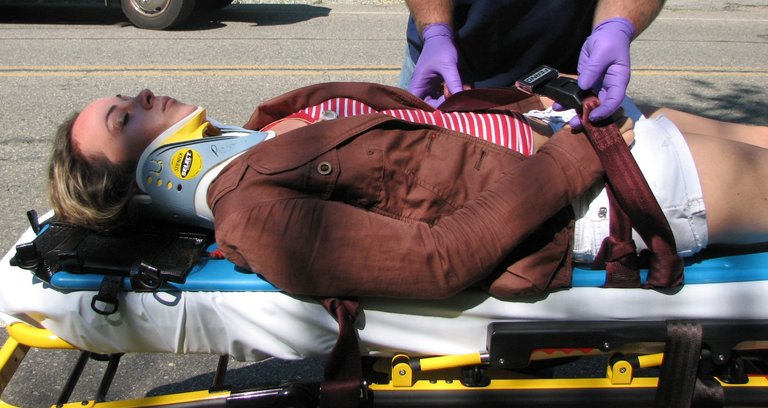Understanding the Impact of Whiplash Injuries
John was on a road trip, aiming to complete a journey that usually takes nine hours at a speed of 100 km/hr. However, being in a hurry, John decided to push his limits and drive at a speed of 180 km/hr, hoping to cut the travel time in half. The ride started off exciting, and it seemed like John was on track to achieve his goal. Unfortunately, things took a turn when he had to suddenly apply the brakes to avoid an accident. The sudden stop resulted in a collision, leading to a whiplash injury. This incident marked the beginning of a new chapter for John.
Before we delve into the details, let's clarify that the discussion on whiplash is not directed toward any specific individual named John, and it is not intended to imply that reckless driving is acceptable. Rather, we will focus on understanding what happens in cases of whiplash.

Whiplash refers to an injury that occurs when the head and neck undergo a sudden and forceful back-and-forth movement. It can be caused by various incidents, including car accidents, sports-related activities, or any event that involves a sudden jolt to the head and neck. It's worth noting that whiplash can result from any sudden, rapid movement that causes the head to move in an exaggerated manner.
In the context of a car accident, whiplash occurs when the seat of the car pushes into the thoracic spine, causing the chest to move forward while the head and upper part of the neck remain relatively still. This differential movement leads to hyperextension of the C7 vertebra in the cervical spine, while the C1 vertebra (atlas) remains relatively stationary. Consequently, the neck drops backward in hyperextension and then whips forward into cervical flexion. ,

It's important to differentiate between sprains and strains. Sprains refer to injuries affecting the ligaments, while strains involve damage to the tendons and muscles. The cervical vertebral column consists of C1, C2, C3, C4, C5, and C6 vertebrae, separated by intervertebral discs that serve as shock absorbers. Maintaining the stability of the cervical vertebral column are several ligaments, such as the anterior longitudinal ligament (ALL) at the anterior side, which limits hyperextension, and the posterior longitudinal ligament, which runs with the dura to protect the spinal cord. The ligamentum flavum is another crucial ligament that safeguards the cervical region., ,
Adjacent to the ligamentum flavum are the spinous processes, bony projections with interspinous ligaments that further limit cervical flexion. Additionally, the nuchal ligament, unique to humans, extends to the occipital bone and helps maintain head alignment during movement. The spinal nerves, branching off the sides of the spinal cord, innervate the muscles and tissues of the upper body. Facet joints in the cervical region allow for neck rotation and are covered with cartilage.,
Ligaments restrict the range of motion, while muscles and tendons facilitate movement. Returning to the topic of sprains and strains, these injuries can be categorized into three grades: grade 1, grade 2, and grade 3. Grade 1 involves minor ligament damage, causing inflammation, swelling, bruising, and potential loss of range of motion. Grade 2 signifies a partial tear of the ligament, while grade 3 indicates a complete tear. Grade 1 injuries typically heal with rest, while grade 2 requires rehabilitation, and grade 3 necessitates complete ligament replacement. , ,
Whiplash injuries can fall under any of the three grades of sprains or strains. Those affected by whiplash syndrome may experience neck sensitivity, tightness, and stiffness. Headaches, shoulder pain, and radiating neurological pain are also common symptoms. Whiplash can damage the tissues surrounding the nerves or directly impact the nerves themselves.,
If you experience whiplash, it is crucial to seek medical attention from a qualified doctor rather than relying solely on massage therapists or other non-medical practitioners. Medical imaging may be necessary to assess the extent of the injury, ensuring appropriate treatment. It's important to remember that whiplash can have long-term implications that may not be immediately evident, even if the symptoms initially seem subtle.
I am very careful when it has to do with traveling in a car. I always caution the driver not to go above the expected limit and not to apply the brake suddenly because I do not want to have a neck issue. In all, I will always use my seat belt, because I am not willing to lose my life to an accident.
Yay! 🤗
Your content has been boosted with Ecency Points, by @eni-ola.
Use Ecency daily to boost your growth on platform!
Support Ecency
Vote for new Proposal
Delegate HP and earn more
Thanks for your contribution to the STEMsocial community. Feel free to join us on discord to get to know the rest of us!
Please consider delegating to the @stemsocial account (85% of the curation rewards are returned).
Thanks for including @stemsocial as a beneficiary, which gives you stronger support.
Congratulations @eni-ola! You have completed the following achievement on the Hive blockchain And have been rewarded with New badge(s)
Your next target is to reach 70000 upvotes.
You can view your badges on your board and compare yourself to others in the Ranking
If you no longer want to receive notifications, reply to this comment with the word
STOPCheck out our last posts:
My mom had a whiplash injury to her lower back when her car was hit by another car. Though the hit itself wasn't that great and the car was mostly fine, the whiplash she felt was intense.